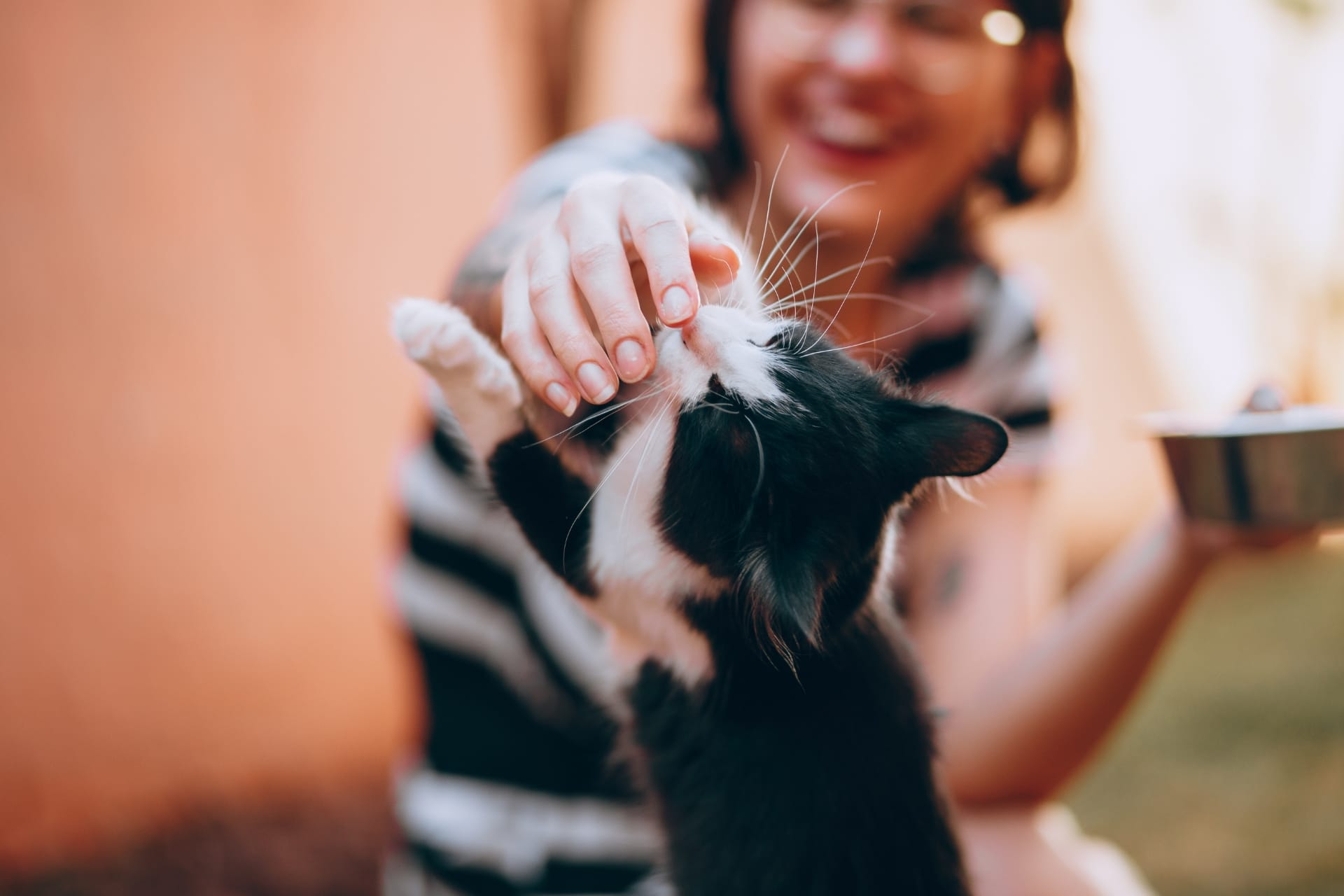TL;DR: Pet sitting keeps your pet happy at home or offers a flexible career for animal lovers. Pet owners can find trusted sitters on Petme, choose the right services, and prep their pets. Sitters can start easily, manage tasks, and grow a client base. This guide covers everything about pet sitting, from costs to services like boarding and dog walking.
Introduction: What is pet sitting?
Pet sitting is a professional service where a trusted individual cares for your pet, typically in your home or theirs, ensuring they’re fed, exercised, and loved while you’re away. Unlike kennels, which place pets in unfamiliar environments, pet sitting keeps your dog, cat, or other pet in a comfortable setting, reducing stress and maintaining their routine. For pet owners with packed schedules, pet sitting saves time and prioritizes pet health and happiness. For animal lovers, it’s a rewarding career—flexible, engaging, and a chance to work with pets daily. Whether you’re a pet owner needing reliable care or someone exploring a side hustle, pet sitting offers solutions for both. Petme connects owners with vetted sitters through a community-driven platform, making it easy to find or become a sitter. This guide dives into every aspect of pet sitting, from finding the perfect sitter to building a career, with tips to make it work for you.
For pet owners: Finding, choosing, and preparing for a pet sitter
When your pet is family, finding a sitter who keeps them happy and healthy is a top priority. Pet sitting can feel daunting with a busy schedule, but with the right approach, it’s a breeze. Here’s how to find, choose, and prepare for a pet sitter who meets your needs (check out this article for an even deeper dive).
How to find a trusted pet sitter
Start by outlining your pet’s specific needs: daily walks for an active dog, medication for an older cat, or playtime for a social bird. Then, visit Petme, a platform where pet owners connect with vetted sitters. Browse profiles with reviews, photos, and service details, filtering by location or needs like overnight care. You can message sitters directly to ask questions or arrange a meet-and-greet. Petme’s community shares recommendations, helping you find reliable sitters fast. Local vet offices or pet stores can also suggest sitters, but Petme’s streamlined platform saves time and builds trust through user feedback.
Choosing the right pet sitter
A great pet sitter matches your pet’s needs and your expectations. Look for experience with your pet’s species—dogs, cats, or exotics—and verify reliability through Petme reviews or references. They should communicate clearly, offering daily updates with photos or videos, and handle health tasks like administering meds or spotting illness. Certifications from Pet Sitters International, often listed on Petme, add credibility. Avoid sitters with no reviews, unclear profiles, or those who don’t ask about your pet’s routine. A meet-and-greet, virtual or in-person, confirms they connect with your pet. Trust your gut to ensure a good fit. For more tips, read our guide on how to choose the right pet sitter.
Preparing your pet and home
Setting up your sitter for success keeps your pet comfortable. Introduce your pet to the sitter gradually with short visits to build trust. Maintain their routine—same food, walk times, and bedtime—to avoid stress. Create a detailed instruction sheet (or include this information in your pet’s Petme profile under “Pet Sitting Instructions”) with feeding schedules, medication doses, favorite toys, and your vet’s contact info. Label pet supplies, clear clutter to prevent accidents, and leave extra food and treats. For cats, note hiding spots. A cozy pet bed helps them relax. Proper prep ensures a smooth experience, letting you focus on your trip. Check our home prep checklist for more details.
Questions to ask a pet sitter
Interviewing a sitter ensures they’re the right fit. Ask about their experience with your pet’s species, their approach to emergencies (e.g., a pet eating something they shouldn’t), and how they’ll handle your pet’s quirks, like a dog’s separation anxiety. Inquire about their availability, communication style, and comfort with tasks like giving meds. On Petme, you can review their profile for certifications or reviews that answer these questions. A good sitter will ask you questions too, showing they care about your pet’s needs. Prepare a list to feel confident in your choice. Learn more in our guide on questions to ask a pet sitter.
Reviewing your pet sitter
After the job, leave a review on Petme to help other owners and reward great sitters. Highlight specifics: Did they send daily updates? Were they punctual? Did your pet seem happy? Be honest but fair—mention any issues constructively. A strong review boosts a sitter’s visibility and builds Petme’s community trust. If they went above and beyond, like calming your anxious cat, say so. Writing a review takes a minute but strengthens the pet care network. See examples in our guide on good pet sitter review examples.
Your inbox needs this
Subscribe to the Petme newsletter for weekly updates with pet care tips, tales, and member-only perks.

For sitters: Becoming a pet sitter, responsibilities, and career tips
Pet sitting is a flexible, rewarding career for those who love animals. Whether you’re new or aiming to grow, here’s how to start, manage responsibilities, and succeed as a pet sitter.
Becoming a pet sitter
You don’t need extensive experience to become a pet sitter—just a passion for animals and a commitment to learning. Start by joining Petme, where you can create a profile showcasing your skills and availability. No formal qualifications are required, but a pet first aid course or certification from Pet Sitters International boosts credibility. Gain hands-on experience by volunteering at shelters to work with dogs, cats, or other pets. On Petme, list services like daily visits or overnight stays, and promote your profile in the community to attract clients. New to the game? Our guide on becoming a pet sitter with no experience offers practical steps.
Pet sitter responsibilities
Your core job is keeping pets safe, healthy, and happy. Daily tasks include feeding pets per their schedule, providing fresh water, and cleaning litter boxes or yards. Exercise varies—walk dogs, play with cats, or engage other pets based on their energy. Monitor health, noting signs like lethargy or appetite changes, and report issues to owners via Petme or phone. Administer medications or follow special diets carefully. Send daily updates with photos or videos to reassure owners. You might also water plants or bring in mail as a house sitter. Adapt to each pet’s personality for a tailored experience. For specifics, see our dog sitter or cat sitter guides.
Career tips for pet sitters
Success in pet sitting comes from trust and reputation. Craft a compelling pet sitter bio on Petme, emphasizing your love for animals and training. Respond to client messages quickly and arrive on time. Request reviews on Petme after each job to increase visibility. Share pet care tips or experiences in Petme’s community to attract clients. Set competitive rates based on local averages and adjust as you gain experience. Offer extras like grooming to stand out. Stay organized with a booking calendar and keep learning through Petme resources or courses. Pet sitting can grow into a full-time career with dedication.
Creating a standout pet sitter profile
Your Petme profile is your digital storefront, so make it shine. Write a clear, engaging bio that highlights your experience, pet preferences (e.g., dogs, cats), and services like boarding or dog walking. Include high-quality photos of yourself with pets (with permission) to build trust. List certifications, like pet first aid, and specify availability for drop-in visits or house sitting. Update your profile regularly with new reviews or skills. A strong profile attracts more clients and sets you apart in Petme’s community. Need help? Check out these pet sitter bio examples for tips and samples.
Handling pet sitting emergencies
Emergencies, like a pet getting sick or injured, can happen, so be prepared. Know the owner’s vet contact and have a pet first aid kit handy. If a dog eats something toxic or a cat stops eating, contact the owner via Petme and follow their instructions—often, a vet visit is needed. Stay calm to keep the pet relaxed, and document the incident for the owner. Training in pet first aid, available through Pet Sitters International, equips you for these situations. Being proactive builds owner trust and strengthens your reputation. Learn more in our guide on pet sitter emergencies.
Costs and services: Dog sitting, cat sitting, multi-pet households
Pet sitting costs and services depend on the pet, location, and care type. Understanding these helps owners budget and sitters set fair rates, while Petme’s services cater to diverse needs.
Pet sitting costs
In the US, pet sitting costs $15–$100 daily. A 30-minute visit for feeding or walking is $15–$25, while overnight stays range from $50–$100. Factors like location, pet needs, and extras (meds, multiple pets, holidays) impact prices. On Petme, sitters display rates, helping owners compare. Owners can save by booking early or sharing sitters for multi-pet homes. Sitters should check local rates on Petme, starting at $15–$20 per visit and increasing with experience or certifications. Clear pricing builds trust for both parties.
Services for dogs, cats, and multi-pet households
Dog sitting includes walks, feeding, playtime, and sometimes training support, with 1–3 daily visits or overnight stays for active dogs. Cat sitting involves feeding, litter box cleaning, and play, typically needing 1–2 visits. Multi-pet households require managing multiple schedules and preventing conflicts, often needing 2–3 visits and $5–$10 extra per pet. Owners must provide clear instructions, and sitters should adapt to each pet’s needs. Petme’s platform matches services to preferences, ensuring a good fit. See our multi-pet guide for more.
Petme’s pet sitting services
Pet sitters on Petme can offer a range of services to suit every pet and owner:
– Boarding: The pet stays overnight in the sitter’s home, receiving personalized care. Ideal for trips or extended absences, it’s like a vacation for your pet.
– Dog Walking: The sitter walks one or multiple dogs, keeping them active and healthy. Perfect for busy days, with schedules tailored to each dog’s energy.
– House Sitting: The sitter stays at the owner’s home to care for their pet and secure their property. Great for long trips or pets needing familiar surroundings.
– Drop-In Visits: Short check-ins to feed, play, or check on the pet at their home. Ideal for late workdays or quick bathroom breaks.
Find these services on Petme, where sitters detail their offerings for easy booking.
Comparing pet sitting to other care options
Pet sitting stands out from alternatives like kennels or doggy daycare. Kennels place pets in shared spaces, which can stress sensitive animals, while pet sitting offers personalized care in a familiar environment. Daycare suits social dogs but requires drop-offs, which busy owners may not have time for. Pet sitting’s flexibility—boarding, house sitting, or drop-in visits—caters to varied needs, and Petme’s platform makes it easy to choose. Sitters benefit from offering multiple services, increasing bookings. For a deeper dive, read our guide on dog sitting vs. doggy daycare.
Conclusion: Your pet sitting roadmap
Pet sitting is the way for keeping pets happy and healthy, whether you’re an owner needing care or a sitter building a career. Owners can use Petme to find trusted sitters, ask the right questions, and prep their homes. Sitters can start with a Petme profile, handle tasks like dog walking or boarding, and grow through community engagement. Costs range from $15–$100 daily, with services tailored to dogs, cats, or multi-pet homes. This guide covers every angle, making pet sitting simple and effective. Join Petme to connect with the pet care community and ensure your pet—or your career—thrives.
FAQs: Your pet sitting questions answered
For pet owners
How do I know if a pet sitter is trustworthy? Check their Petme profile for reviews, certifications, and a detailed bio. Meet them to see how they interact with your pet and ask for references.
What’s the difference between pet sitting and kennels? Pet sitting offers personalized care at home or a sitter’s, while kennels place pets in shared spaces, which can be stressful.
How often should a pet sitter visit? Dogs need 1–3 visits daily for walks and feeding; cats need 1–2. Book a schedule on Petme based on your pet’s routine.
Can pet sitters give my pet medication? Yes, most sitters can handle meds with clear instructions. Confirm their experience on Petme during the meet-and-greet.
How do I write a good review for a sitter? Highlight specifics like punctuality or pet happiness on Petme. See our review examples for tips.
For pet sitters
Do I need certifications to start? No, but pet first aid or Pet Sitters International certifications help. Start with a Petme profile to attract clients.
How much should I charge as a beginner? Start at $15–$20 per 30-minute visit, based on local rates. Check Petme for averages and adjust with experience.
What are my daily responsibilities? Feed pets, provide water, exercise them, clean litter boxes or yards, monitor health, and send updates via Petme.
How do I get more clients? Build a strong Petme profile, request reviews, and share tips in Petme’s community.
Can pet sitting be full-time? Yes, with consistent bookings. Learn how in our guide on pet sitting as a full-time job 🐾.











